- Home
- Search
- Images
- Datasets
- Sample Use
- How to Cite
- Additional Information
- About NEON
- NEON Data Portal
- ASU Biocollections
- About Symbiota
|
|
|
|
Family: Cactaceae
scarlet hedgehog cactus
|
Plants commonly 20-100(-500)-branched, loosely aggregated into clumps or tightly packed into rounded mounds, to 100 cm diam. Stems erect, cylindric (or spheric), 5-40 × 4-15 cm; ribs (5-)6-14, crests slightly (or conspicuously) undulate; areoles 10-20(-42) mm apart. Spines (1-)5-16(-22) per areole, mostly straight except on unusually long-spined individuals, ashy white to gray, brown, yellowish, reddish, or black, often dark tipped; radial spines (1-)4-13(-18) per areole, appressed to slightly projecting, (3-)5-40(-49) mm; central spines 0-6 per areole, spreading to projecting outward, terete (to angular), (5-)10-80 mm. Flowers unisexual, (2.5-)3.8-8(-9) × (1.5-)3-7 cm; flower tube (12-)15-40 × 8-30 mm; flower tube hairs usually 1-2 mm; inner tepals crimson or scarlet, less often orange-red (very rarely rose-pink), with or without whitish or yellowish (or pink) proximal portion, usually 14-40 × 5-16 mm, tips thick and rigid; anthers usually pink or purple (rarely yellow); nectar chamber 4-10 mm (longer if measurement includes tube formed by connate stamen bases). Fruits greenish or yellowish to pinkish, bright red or brownish tinged, 20-40(-72) mm or less, pulp white. 2n = 44. Flowering late Mar-Jun; fruiting 2-3 months after flowering. Chihuahuan Desert, desert scrub, desert grasslands, pinyon-juniper and oak woodlands, Great Plains grasslands, montane forest, bajadas, rocky slopes, and cliffs, igneous, metamorphic, and limestone substrates; 150-2700(-3000) m; Ariz., Colo., N.Mex., Tex.; Mexico (Chihuahua, Coahuila, Sonora). Tetraploids belonging to Echinocereus coccineus constituted the greater part of L. D. Benson´s concept (1969, 1969b, 1969c, 1982) of E. triglochidiatus var. melanacanthus (see also discussion under 12. E. triglochidiatus). Where sympatric, the diploids and tetraploids are usually different in appearance, except in southeastern Arizona and extreme southwestern New Mexico (see discussion under 13. E. arizonicus), and in northern Arizona. The common, tetraploid, claret-cup cacti of southeastern Arizona mountain ranges have bisexual flowers, and they have been named Echinocereus santaritensis W. Blum & Rutow. Similar plants from southwestern New Mexico are the basis for E. coccineus subsp. aggregatus [also called E. aggregatus (Engelmann ex S. Watson) Rydberg]. Populations of Echinocereus coccineus form an intergrading series from densely spine-covered typical coccineus in Colorado and northern New Mexico to sparsely spined plants in west-central Texas. Populations in the mildest climates have strikingly large stems, but shrink when transplanted (D. Weniger 1970). Populations intermediate between those extremes in the El Paso region sometimes are segregated as E. coccineus subsp. rosei. Populations in northwestern Arizona with unusually small, narrow flowers Echinocereus toroweapensis (P. C. Fisher) Fuersch appear identical to E. canyonensis Clover & Jotter (M. A. Baker, pers. comm.). A type specimen for E. toroweapensis was apparently never preserved, so the name may be invalid. Populations in the granitic region of central Texas (chromosome number unknown), probably belonging in Echinocereus coccineus, have been called E. coccineus subsp. roemeri (Muehlenpfordt) W. Blum, Mich. Lange & Rutow. Spines are more numerous than in the surrounding populations on limestone. Echinocereus coccineus var. gurneyi (L. D. Benson) D. Ferguson was based on a short-spined plant, apparently introgressed from E. dasyacanthus, and so it pertains to E. ×roetteri Rümpler in the broad sense. It is not a true geographic race of E. coccineus. Echinocereus santaritensis and the diploid called E. nigrihorridispinus (see discussion under 13. E. arizonicus) are ecologically and reproductively segregated but difficult to distinguish morphologically, especially when sterile. Spines of E. santaritensis tend to be thinner but only extremes are identifiable by spine thickness alone. Arizona reports of E. triglochidiatus var. neomexicanus were based on robust individuals from both of those taxa, whereas slender-spined specimens were identified mostly as E. triglochidiatus var. melanacanthus. Arizona reports of E. polyacanthus were based on either the hairy salverform flowers of E. santaritensis FNA 2004, Allred 2012, Heil et al. 2013 Duration: Perennial General: Hedghog-like cactus, consisting of many small cylindric stems tightly aggregated together in clumps or mounds up to 1 m wide; stems 20-100 or more per mound or clump; each stem erect, cylindric to spheric, 5-40 cm tall and 4-15 cm in diameter, with about 9-12 ribs; ribs slightly or conspicuously undulate, with areoles (axillary buds from which the spines emerge) usually 1 cm apart at the crests of the undulations. Spines: Spines usually 5-16 per areole, mostly straight except on unusually long-spined individuals, the spine color white to yellow, reddish-brown, or black, and often dark tipped; about 3-4 of these are central spines, which are 1-6 cm long, project outward, and are round in cross section or occasionally subulate (awl-shaped, or wider at the base); the rest of the spines are radial (emerging from the outside edge of the areole), 5 mm to 3 cm long, and appressed to the cactus stem or slightly projecting away from the cactus. Flowers: Plants dioeceous (with male and female flowers on separate plants), or flowers bisexual; flowers 3-9 cm high and 2-7 cm wide; petals 2-4 cm high and 1-16 mm wide, red, sometimes orange, or rarely pink or white, sometimes paler at the base, with thick, rigid tips; anthers usually pink or purple (rarely yellow); stigma lobes green. Fruits: Fruits juicy and spiny, 2-4 cm long, the skin usually brownish or reddish, sometimes green, and the inner pulp white; seeds dark colored, 1-2 mm long. Ecology: Found on bajadas, rocky slopes, and cliffs, on igneous, metamorphic, and limestone substrates, associated with a wide variety of vegetation community types from Chihuahuan desert up to montane conifer forest, below 10,000 ft (3048 m); flowers late March-J Distribution: AZ, CO, NM, TX; south to n MEX Notes: This is the red to orange flowered claret cup cactus. Look for large mounds of closely clustered cactus stems, each stem about 10 or 20 cm tall. In late spring this species is unmistakable with its striking red flowers. Can be easily confused with a few other hedgehog-like cacti. E. triglochadatus has 10 or fewer ribs per stem (usually 9-12 ribs on E. coccineus); 0-2 central spines (usually more than 2 central spines on E. coccineus) and the spines are angular in cross section (mostly rounded to subulate, or wider at the base, on E. coccineus). E. triglochiatus has flowers which are slightly darker in color, open less widely, and are always bisexual, with good pollen and ovules when dissected. E. coccineus is usually dioecious (with male and female flowers on separate plants) , but this may not be obvious to the casual observer, as both sexes of flowers have male and female parts; female flowers have reduced, nonfunctional stamens, and male flowers have reduced stigmas with abortive ovules. Ethnobotany: Fruits are edible; plants used as heart medicine by the Navajo and were considered poisonous. Etymology: Echinocereus is from echinos, spiny, and cereus, candle; coccineus means deep red. Editor: AHazelton 2017 |
|
|
|


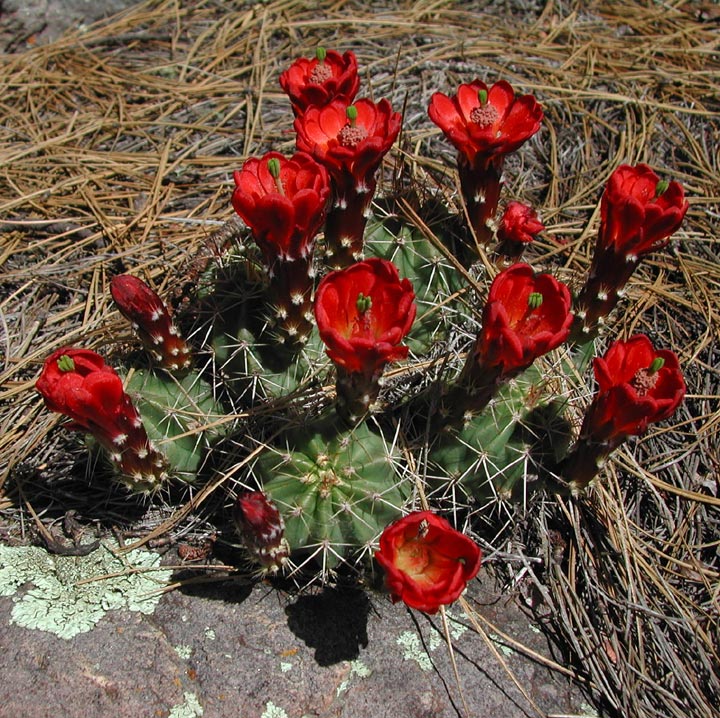
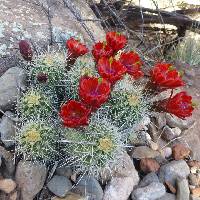
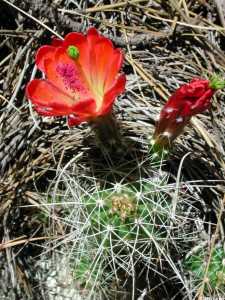
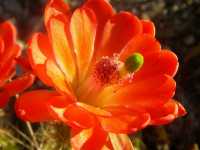
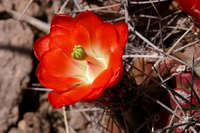
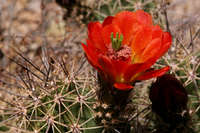
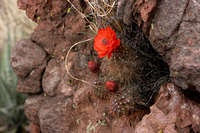
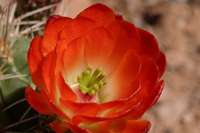
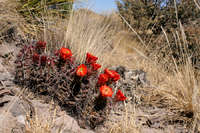
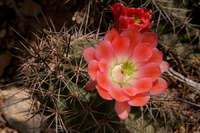
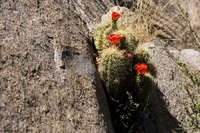
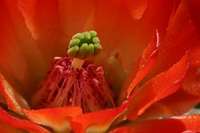
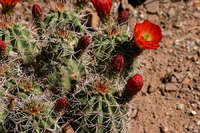
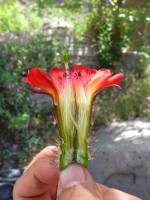
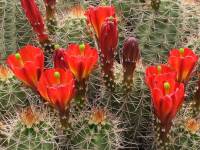
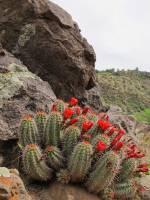
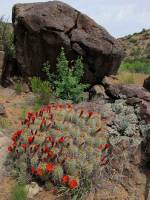
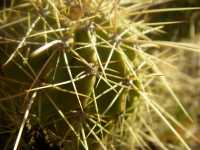
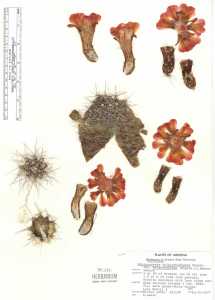
_tn.jpg)